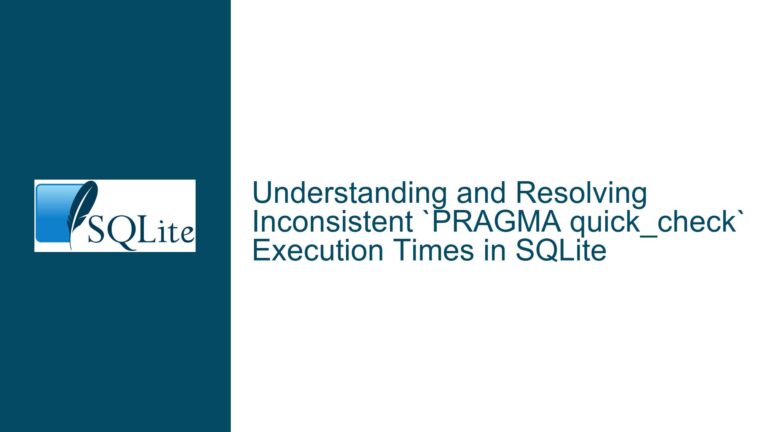Does SQLite Optimize Unused Tables and Columns in Views?
Understanding SQLite View Optimization Behavior for Unused Tables and Columns
Issue Overview
When working with SQLite, a common strategy to simplify complex queries is to create a consolidated view that joins multiple tables and selects numerous columns. This "super-view" approach aims to reduce repetitive joins across different queries. However, a critical performance concern arises: Does SQLite automatically optimize the execution plan by excluding unused tables and columns when querying such a view, or does it process the entire view before applying subsequent filters and projections?
This question revolves around SQLite’s query optimizer and its ability to eliminate unnecessary components (tables, joins, columns) when a view is queried. If the optimizer cannot prune unused elements, queries against the view may suffer from unnecessary computational overhead, defeating the purpose of using a view for efficiency.
Key aspects of the issue include:
- View Materialization: Whether SQLite materializes the full result set of the view before applying filters or projections.
- Join Elimination: Whether tables involved in joins are excluded from the execution plan if their columns are not referenced.
- Column Pruning: Whether unused columns are omitted during query processing.
- Impact of Join Types: How
LEFT JOIN,INNER JOIN, and other join operations influence optimization.
For example, consider a view SuperView that joins tables A, B, C, and D, selecting 20 columns across these tables. If a query against SuperView only references columns from A and B, does SQLite execute joins with C and D? Similarly, if a table in a LEFT JOIN is not referenced, is it excluded from the query plan?
Factors Influencing SQLite’s Join and Column Elimination
Possible Causes
SQLite’s ability to optimize unused tables and columns depends on several factors tied to query structure, join semantics, and the query planner’s constraints. Below are the primary determinants:
Join Type and Referential Integrity
INNER JOINvs.LEFT JOIN:- Tables in
INNER JOINclauses cannot be eliminated if they affect the result set’s cardinality, even if their columns are unused. For instance, ifTableCisINNER JOINed toTableA, omittingTableCwould alter the number of rows returned, asINNER JOINrequires matching rows in both tables. - Tables in
LEFT JOINclauses may be excluded if no columns from the right-hand side (RHS) table are referenced. For example, aLEFT JOIN TableDclause with noTableDcolumns in theSELECT,WHERE, or other clauses allows SQLite to skip joiningTableD, as it does not affect the result set’s structure.
- Tables in
Column and Table References in Query Clauses
- Projection (SELECT Clause): Columns not listed in the
SELECTclause are candidates for elimination. However, columns used inWHERE,GROUP BY,ORDER BY, orHAVINGclauses still require their parent tables to be included in the execution plan. - Predicate Pushdown: SQLite may push
WHEREclause conditions into the view’s definition, potentially influencing join elimination. For example, aWHEREcondition onTableA.column1could allow the optimizer to excludeTableBif it is joined viaLEFT JOINand no other references exist.
- Projection (SELECT Clause): Columns not listed in the
Query Planner Limitations
- Subquery Flattening: SQLite attempts to flatten subqueries (including views) into the outer query, enabling cross-component optimization. However, this process has limitations. Views with complex joins or aggregates may not be fully flattened, leading to materialization of intermediate results.
- Statistical Metadata: The absence of indexes, outdated
ANALYZEstatistics, or complex expressions can hinder the query planner’s ability to estimate costs accurately, resulting in suboptimal join ordering or elimination.
View Definition Complexity
- Views containing
UNION,GROUP BY, or window functions are less likely to undergo optimization, as these constructs introduce structural dependencies that prevent join or column elimination.
- Views containing
Diagnosing and Resolving Super-View Performance Issues
Troubleshooting Steps, Solutions & Fixes
To determine whether SQLite optimizes unused tables and columns in views, follow these steps:
Step 1: Analyze the Query Plan with EXPLAIN QUERY PLAN
SQLite’s EXPLAIN QUERY PLAN command reveals how the query planner processes a statement. Compare the plans for a minimal query (directly referencing required tables) and the super-view-based query.
Example:
-- Minimal query
EXPLAIN QUERY PLAN
SELECT A.id, A.name
FROM A
INNER JOIN B ON A.id = B.a_id
WHERE A.status = 'active';
-- Super-view-based query
EXPLAIN QUERY PLAN
SELECT id, name
FROM SuperView
WHERE status = 'active';
Interpreting Results:
- If both plans show identical table scans (
SCAN TABLE A,SEARCH TABLE B USING INDEX...), the optimizer successfully eliminated unused tables in the view. - If the super-view plan includes references to
CorD, those tables are not optimized out.
Step 2: Use EXPLAIN for Low-Level Opcode Analysis
The EXPLAIN command outputs the virtual machine opcodes generated for a query. Longer opcode lists indicate more processing steps, potentially revealing unoptimized joins or columns.
Example:
EXPLAIN
SELECT id, name FROM SuperView WHERE status = 'active';
Key Indicators:
OpenReadorOpenEphemeralinstructions for tablesCorDsuggest they are being accessed unnecessarily.Columnopcodes referencing columns from unused tables indicate a lack of column pruning.
Step 3: Test Join Elimination Scenarios
Validate whether SQLite eliminates tables based on join type and column usage:
LEFT JOINUnreferenced Table:CREATE VIEW View1 AS SELECT A.* FROM A LEFT JOIN B ON A.id = B.a_id; EXPLAIN QUERY PLAN SELECT * FROM View1;- If the plan shows only
SCAN TABLE A,Bis optimized out.
- If the plan shows only
INNER JOINUnreferenced Table:CREATE VIEW View2 AS SELECT A.* FROM A INNER JOIN B ON A.id = B.a_id; EXPLAIN QUERY PLAN SELECT * FROM View2;- The plan must include
SCAN TABLE AandSEARCH TABLE B, asINNER JOINaffects row count.
- The plan must include
Step 4: Optimize View Design
- Avoid Over-Joining: Split the super-view into smaller views that group related tables. Use CTEs (Common Table Expressions) for complex queries.
- Index Strategically: Ensure all join and filter columns are indexed to aid the query planner in estimating costs and eliminating joins.
- Materialize Critical Views: For read-heavy workloads, precompute results using
CREATE TABLE ... AS SELECTinstead of views.
Step 5: Validate with Real Data
Testing with production-scale data exposes optimization gaps not visible in small datasets. Use .timer on in the SQLite CLI to measure execution times.
Example:
.timer on
-- Query 1: Minimal query
SELECT A.id FROM A INNER JOIN B ON A.id = B.a_id;
-- Query 2: Super-view query
SELECT id FROM SuperView;
Consistent timing between the two queries suggests effective optimization.
By systematically analyzing query plans, refining view definitions, and leveraging indexing, developers can mitigate the risks of unoptimized super-views in SQLite.






